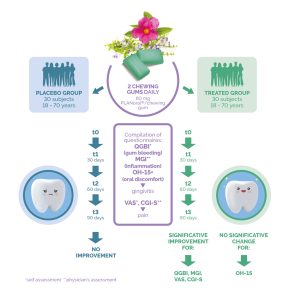
An aid against periodontal diseases by PLANoràl®
Periodontal diseases are among the 6 most common non-communicable diseases worldwide. In particular, gingivitis, a mild inflammation of the gums, which, if left untreated, may progress to more serious periodontitis, according to a survey conducted by the GfK research institute and sponsored by GSK Consumer Healthcare, affects approximately 23 million Italians.
Symptoms and causes of gingivitis and periodontitis
Gingivitis is the mildest form of periodontal disease; irritation, redness, swelling, and pain of the gums when eating hot or cold foods are the most common symptoms, along with bleeding and halitosis (bad breath), but only 57% of those affected recognize their condition and seek expert help to treat it.
Gingivitis is generally due to poor oral hygiene and lack of regular dental check-ups, but if not promptly treated, it can evolve into more severe irreversible forms (periodontitis), which can also cause tooth loss.
So, let's see where gingivitis comes from: in the warm and moist oral mucosa, over 700 species of microorganisms, predominantly bacteria, live in balance with the host; this symbiotic state is called "eubiosis". When it is altered for any reason, "bad" bacteria, such as Porphyromonas gingivalis, can proliferate; they are part of the plaque, the film that constantly deposits on the tooth. For this reason, it is important to brush your teeth at least twice a day: mechanical action allows the partial removal of plaque and thus bacteria. Over time, the plaque hardens turning into tartar, which adheres at the base of the tooth itself; tartar must be removed by the dentist: hence the importance of regular check-ups. If this does not happen, the gums begin to swell, causing the symptoms we have described above, and can evolve into a chronic state no longer reversible, called periodontitis.
From periodontitis to systemic inflammation
Periodontitis, as emerged from a 2021 study published in Frontiers in Physiology (Periodontal Inflammation and Systemic Diseases: An Overview), is also a constant potential source of systemic infection and inflammation: higher levels of systemic inflammation biomarkers have indeed been observed in patients with periodontal disease, such as pro-inflammatory cytokines (TNF-α, IL-1, and IL-6) and C-reactive protein, as a result of microbial translocation from periodontal lesions.
As early as a 2012 study published in the Journal of Indian Society of Periodontology (Periodontitis and systemic diseases: A literature review) showed how infections and inflammations caused by periodontitis can spread to other organs through the blood and represent an additional risk factor for cardiovascular and cerebrovascular disorders, respiratory diseases, diabetes, insulin resistance, obesity, rheumatoid arthritis, osteoporosis, complications of pregnancy, and premature births.
READ ALSO: Healthy mouth, healthy body: the link between oral health and systemic diseases
The combination of Cistus incanus L. and Scutellaria lateriflora L. (PLANoràl®) for oral health
Preclinical studies published in the scientific journal Foods (In Vitro Antimicrobial and Antibiofilm Properties and Bioaccessibility after Oral Digestion of Chemically Characterized Extracts Obtained from Cistus × incanus L., Scutellaria lateriflora L., and Their Combination) have already highlighted how the combination of Cistus incanus L. and Scutellaria lateriflora L. (PLANoràl®) has specific antimicrobial action on P. gingivalis, as well as reducing the formation of biofilm (i.e., subgingival plaque that forms on the tooth at the beginning of the process examined above) by approximately 80%; promising effects potentially useful for the treatment of gingivitis.
READ ALSO: Plant extracts from Cistus incanus L. and Scutellaria lateriflora L.: their combination has antimicrobial and antibiofilm properties, preventing periodontal diseases
A clinically relevant and statistically significant improvement in gingival health
 Now a new study published in the journal Nutrients on March 16, 2024 (Efficacy and Tolerability of a Scutellaria lateriflora L. and Cistus × incanus L.-Based Chewing Gum on the Symptoms of Gingivitis: A Monocentric, Randomized, Double-Blind, Placebo-Controlled Clinical Trial) confirms the potential beneficial activity of PLANoràl®. The blend was used to prepare chewing gums to ensure prolonged contact with the oral cavity; the 3-months treatment, twice a day, caused a clinically relevant and statistically significant improvement in the gingival status of the volunteers who took PLANoràl® during the study compared to the placebo, particularly improving the symptoms associated with gingivitis and avoiding worsening towards periodontitis.
Now a new study published in the journal Nutrients on March 16, 2024 (Efficacy and Tolerability of a Scutellaria lateriflora L. and Cistus × incanus L.-Based Chewing Gum on the Symptoms of Gingivitis: A Monocentric, Randomized, Double-Blind, Placebo-Controlled Clinical Trial) confirms the potential beneficial activity of PLANoràl®. The blend was used to prepare chewing gums to ensure prolonged contact with the oral cavity; the 3-months treatment, twice a day, caused a clinically relevant and statistically significant improvement in the gingival status of the volunteers who took PLANoràl® during the study compared to the placebo, particularly improving the symptoms associated with gingivitis and avoiding worsening towards periodontitis.
To learn more about PLANoràl®, our dry extract obtained from plants identified by DNA barcoding, download our brochure.